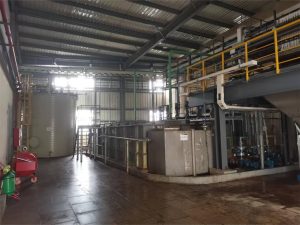Solvents are selected based on solubility, selectivity, boiling point, safety, and cost; high yield and low toxicity are prioritized, with efficiency and affordability as goals.
Solubility
Solubility in Extraction Solvents
Solubility is one of the fundamental properties that determines the choice of extraction solvent. This determines how well the solvent dissolves the analyte, which is a key factor in achieving good extraction. High solubility of the target in the solvent provides excellent yield and purity.
Factors Affecting Solubility
Solubility is an important property that is affected by temperature, pressure, and the chemical properties of the solute and solvent. For example, nonpolar solvents (such as) are able to extract nonpolar compounds; polar solvents (such as
Solubility Parameters
In this regard, the Hildebrand solubility parameter can be used to numerically estimate solubility. It is a numerical value that predicts the dissolution behavior of a substance in a particular solvent. For example, a solute generally dissolves better in a solvent with a comparable Hildebrand parameter value to the solute itself.
Real-World Example
For example, consider the process of extracting caffeine from coffee beans. Caffeine is a polar molecule, so when you put it in water (also a polar solvent), it dissolves quickly. However, if you want to extract aromatic oils from coffee beans, you need to use a nonpolar solvent such as hexane.
Temperature and Solubility
In the case of thermodynamics, the first factor that comes into play is explaining why the solubility of a reaction depends heavily on temperature. With few exceptions, higher temperatures increase the solubility of solids and liquids in a solvent. For example, the solubility of sodium chloride in water increases from 35.7 g/100 mL at 0°C to 39.12 g/100 mL at 100°C. mL.
Solubility Testing
It is very important to perform a solubility test before choosing a solvent. You can dissolve a small amount of solute in the solvent at different temperatures and concentrations to understand the optimal extraction conditions.
Selectivity
The central role of selectivity in extraction
Choosing an extraction solvent with selectivity It describes how a selective solvent dissolves the target compound and not other compounds. If the selectivity is high, the extraction process will produce a pure product, free of contaminants.
Mechanism of selectivity
Selectivity is determined by the chemical interaction between the solvent and the target compound. Because polar solvents (water) will preferentially extract polar substances (such as organic acids), while non-polar solvents (such as hexane) are equally effective for non-polar compounds. This principle is crucial in operations such as liquid-liquid extraction and solid phase extraction.
Quantifying selectivity
The partition coefficient Kd is a number that describes selectivity. It is the ratio of the concentrations of a compound in a two-phase system at equilibrium. For example, if a compound has a K_d of 10 in water and hexane, the compound will be 10 times more concentrated in hexane than in water.
Practical applications
For drug extraction, selectivity is of utmost importance. For example, when extracting an active ingredient from a plant, the solvent must selectively dissolve the active ingredient but leave the plant material behind. This can be achieved very effectively using a solvent with a high partition coefficient for the active ingredient
Antibiotic extraction
Refer to antibiotics extracted from fermentation broth. Ethyl acetate is a common choice because it is more selective for antibiotics than other fermentation byproducts. However, because the selective solvent is a stimulus-responsive liquid, the purity of the extracted antibiotic can exceed 90%, even without further purification, demonstrating the versatility of this technology for high-yield antibiotic recovery at the molecular/particle selective removal level, which will reduce downstream purification costs.
Steps to Enhance Selectivity
Solvent polarity, pH, and ionic strength can be adjusted to increase selectivity. For example, increasing pH makes basic compounds more soluble in organic solvents, thereby improving extractability. Similarly, cations in ionic strength will separate unwanted salt partners, leaving the desired compound as the only pure species in solution.
Experimental Validation
Small-Scale Experiments to Select SolventsBefore you begin making, perform small-scale experiments. Use different solvents and conditions to evaluate the selectivity and yield of your target compound. These data from the field are valuable information to find the best extraction method.

Boiling Point
Extraction Solvent Boiling Point Explanation
This is one of the most important factors in the extraction process. It makes the extraction less efficient and makes post-extraction solvent removal more difficult. An ideal extraction solvent has a boiling point that allows the extraction reaction to proceed under safe conditions and reduces the process intensity of subsequent downstream cleanup.
Effect on Extraction Efficiency
The temperature of the extraction is determined by the boiling point. For example, diethyl ether (boiling point 34.6°C) operates at lower temperatures due to its lower boiling point and can be used for heat-sensitive compounds. On the other hand, solvents with higher boiling points, such as dimethyl sulfoxide (DMSO, boiling point: 189°C), allow extraction to be performed at higher temperatures, thereby improving solubility and extraction yield.
Ease of Solvent Removal
The solvent needs to be removed after extraction so that only the desired compounds are left. Solvents with lower boiling points are also easier to evaporate, which reduces energy costs and shortens processing time. A good example is that in countless extraction processes, methanol (boiling point: 64.7°C) is preferred over water (boiling point: 100°C) because the former boils much faster than the latter.
Practical Applications
Solvents such as hexane (boiling point 69°C) are used in the extraction of essential oils because they are relatively easy to remove. This low boiling point causes the solvent to evaporate quickly, minimizing thermal degradation and producing a pure essential oil.
Boiling Point and Compound Stability
It is critical to determine the extraction solvent in which the compound will dissolve and that the boiling point of the solvent remain compatible so that the compound is in good condition. This is the case with many pharmaceutical compounds, which degrade at high temperatures. In other words, less volatile solvents such as chloroform, with a boiling point of 61.2°C, may (probably) cause degradation, and they will obviously leave the entire product intact.
Data-Driven Decision Making
For example, let’s say we want to express some natural pigment. Ethanol boiling point — 78.37°C is a classic solvent because it has a boiling point range suitable for pigment dissolution and extraction. To avoid pigment loss due to thermal decomposition, the boiling point can be closely followed to adjust the extraction process.
Extraction Process
- Solvent Selection: Selecting a suitable solvent with a boiling point suitable for the thermal stability of the compound.
- Dissolution: Dissolving the compound in a solvent under controlled temperature conditions.
- Evaporation: After extraction, the solvent is evaporated at boiling point using a rotary evaporator or similar device.
- Isolation: The pure compound is isolated after complete evaporation of the solvent.

Safety and Toxicity
Evaluating Solvent Safety
Safety Find the right solvent for extraction. Solvents must be safe to handle, store, and dispose of, and must be safe for human health and the environment. From determining flammability and reactivity to potential health hazards.
Toxicity Considerations
Toxicity is the most important factor in choosing a solvent. Highly Toxic Solvents: They can be a serious health hazard, and can cause a range of health problems, including long-term effects such as respiratory tract, skin irritation, and cancer. OSHA and EPA provide guidelines and permissible exposure limits for certain solvents.
Typical Toxic Doses of Solvents
- Hexane: Highly toxic, a neurotoxin.
- Methanol: Toxic, can cause blindness and death if ingested or in contact with the skin.
- Ethanol: Not very toxic, moderately safe but flammable.
Safety Data Sheet (SDS)
Many solvents can cause hazardous and toxic situations, and without a safety data sheet, people would not be able to understand the safety and hazardous properties of these solvents. It provides specific information on handling, storage, and emergency measures in a downloadable SDS. According to the SDS for acetone, acetone is flammable, and side effects include skin irritation and dizziness.
Real-World Example
Safety and toxicity are of greatest concern during food extraction. Non-toxic, non-flammable CO2 is also commonly used in essential oils and flavors. Since supercritical CO2 has GRAS status, there is no food safety risk of any toxic residues in the final product in food.
Steps to Ensure Safety
- Risk Assessment: Perform a thorough risk assessment of potential solvents, taking into account factors such as exposure routes and concentration levels.
- Substitution: Replace hazardous solvents with less toxic solvents when possible. For example, use ethanol instead of methanol for plant extraction.
- Personal Protection: Use appropriate personal protective equipment (PPE) such as gloves, goggles, and ventilation systems to reduce exposure opportunities
- Training and Procedures: All personnel should be trained in safe handling procedures and emergency response.
Solvent Safety Data
According to OSHA, the Permissible Exposure Limit (PEL) for acetone is 1,000 ppm in an 8-hour workday. In comparison, the PEL for methylene chloride is 25 ppm, highlighting the significant difference in toxicity and required safety measures.
Cost and Availability
Evaluating Solvent Costs
Price is a major consideration when selecting an extraction solvent. The total cost certainly includes the purchase price, management, conservation, and disposal price. Ethanol or water are generally cheaper than acetonitrile or dimethyl sulfoxide (DMSO).
Solvent Availability
Solvent Selection The availability of the solvent (or solvents) to the processor is therefore a key factor in determining which solvent to use. Any solvent must be readily available in bulk as needed to meet the needs of the production line. It is difficult to distinguish high purity solvents from these impure common solvents because the level of contamination in them may also be low, but these contaminants are generally easy to avoid in these types of applications. – These impure solvents have the advantage of high availability because hexane and methanol are bulk chemicals and may come from multiple suppliers.
Comparative Cost Analysis
For example, compare the cost of ethanol and acetonitrile. Ethanol is generally priced at around $3/liter, while acetonitrile is priced at over $20/liter, which is too expensive for the process. This can have a large impact, especially in large operations, and therefore affect profits.
Economic Considerations
The solvent selected can greatly affect the cost and economic benefits of production in an industrial environment. Alternatively, pharmaceutical companies can benefit from long-term savings by choosing more expensive but more selective solvents to increase yields and reduce post-processing costs.
Essential Oil Extraction
Ethanol is often used to extract essential oils because it is low-cost and widely available. It is cheaper than solvents such as butane or CO2, and more readily available, making it popular among small to medium-sized processors.
Notes on Reducing Costs and Achieving High Availability
- Do your homework: You can conduct market research to understand prices from different suppliers.
- Buy in bulk: If shelf life/storage permits, buy items in bulk to save on per-unit costs.
- Supplier Reliability: Choose reliable suppliers with high on-time delivery rates and consistent quality.
- Local Sourcing: Source solvents locally whenever possible to save on cost-effective shipping options and reduce delivery times.
Data-Driven Decision Making
Examining data on historical solvent price and availability changes For example, tracking ethanol pricing over the past 5 years can provide insights into market conditions and predict future budgets.
Biotech Industry
For example, in the biotech industry, the price of solvents such as isopropyl alcohol and acetone can have a significant impact on operating budgets. To mitigate these risks, companies negotiate long-term contracts with suppliers to purchase inputs at prices set today, but with delivery dates in the future due to production lead times.
